Apple AirTag Review: With power comes responsibility
- Seamless setup
- Find My network is vast
- Great battery life, and you can replace it yourself
- Precision Finding feels magical
- Accessories cost extra
- Some legitimate concerns around privacy defaults
- No Android support
There's nothing quite so unpleasantly distinctive as the feeling of your stomach dropping when you realize your keys, laptop bag, or another important item has gone missing. Apple's pill-shaped AirTag isn't quite the perfect medicine for preventing that lurching sensation, but the long-anticipated $29 tracker does go a long way to settling some of the discomfort around lost or misplayed items.
Simple hardware, simple setup
A white and silver lozenge of plastic and stainless steel, AirTag is 1.26 inches in diameter and 0.31 inches thick, and it tips the scales at just 0.39 ounces. A quarter of that weight is actually the CR2032 button cell battery inside. Unlike most Apple products in recent memory, you can open your AirTag up and swap out the battery yourself, though the company says you'll only need to do that roughly each year.
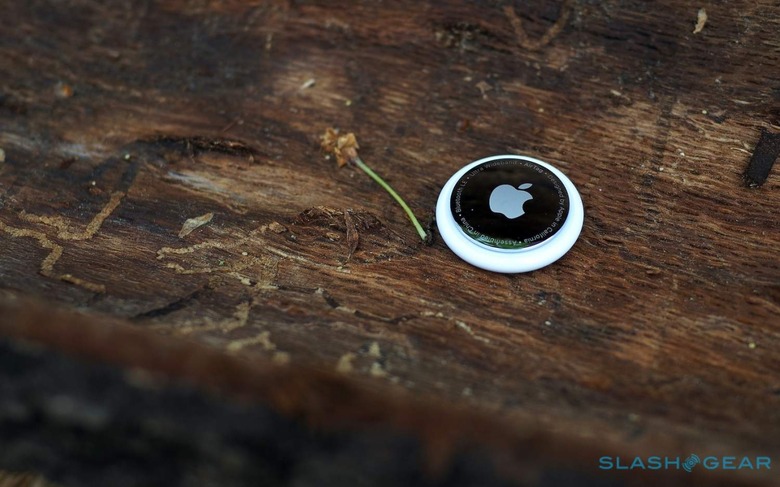
Despite the twist-off rear panel, AirTag is still IP67 splash, water, and dust resistant. It'll handle dunks in up to a meter of water, for up to 30 minutes, and should still survive.
As we saw with AirPods and other U1-equipped devices, setup is a particular joy. Pulling off the protective plastic wrap automatically turns the AirTag on. Hold that next to your iPhone or iPad and – as long as they're running iOS 14.5 or iPadOS 14.5 respectively – a pop-up message will ask you to connect.
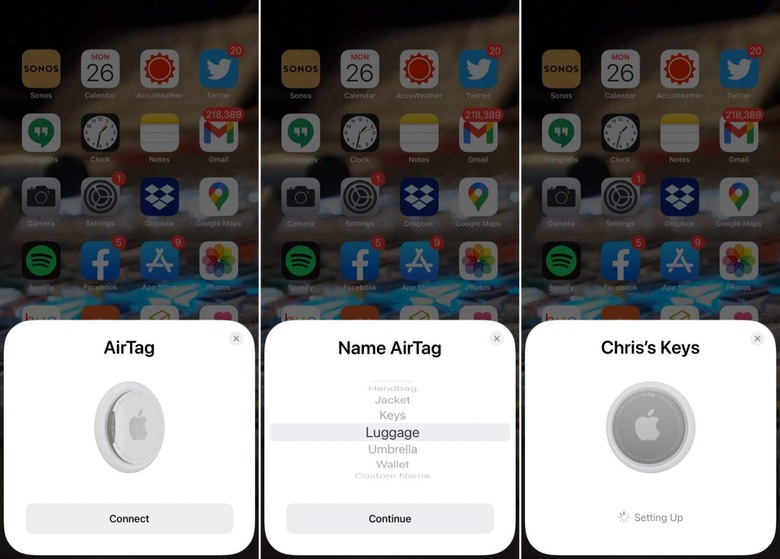
From there it's a matter of naming the AirTag – you can rename it later, too – and then jumping into the Find My app, whereupon the tracker appears in the Items tab. It's charmingly simple, and it makes the "hit search and wait" process for other Bluetooth trackers feel lumpy and tedious by comparison.
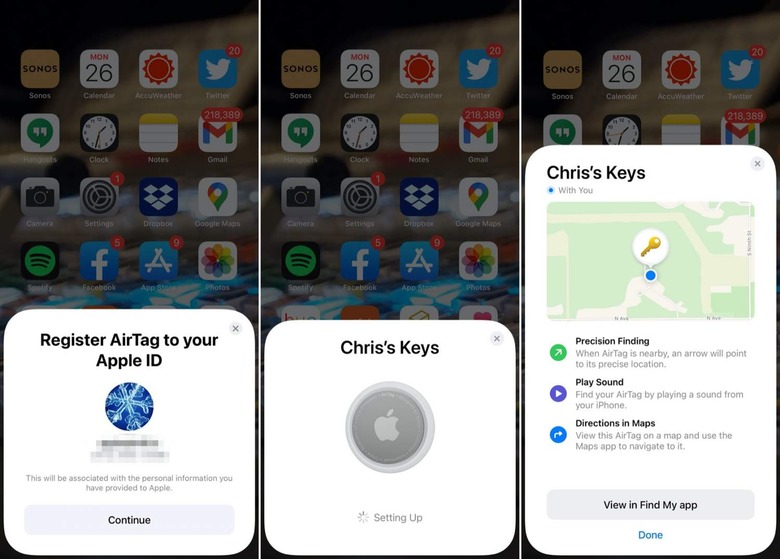
Here's your AirTag - now go shopping for accessories
Apple has always outdone itself with accessories to go with each new product, but few launches have so clearly made them essentials as AirTag. In the tracker equivalent of making you exit via the gift shop, the perfectly round gadget lacks any way to fix, tie, or tether it to your keys, luggage, or any other item. Where most rival trackers at least include a little hole through which you can hook a keychain, Apple's does not.
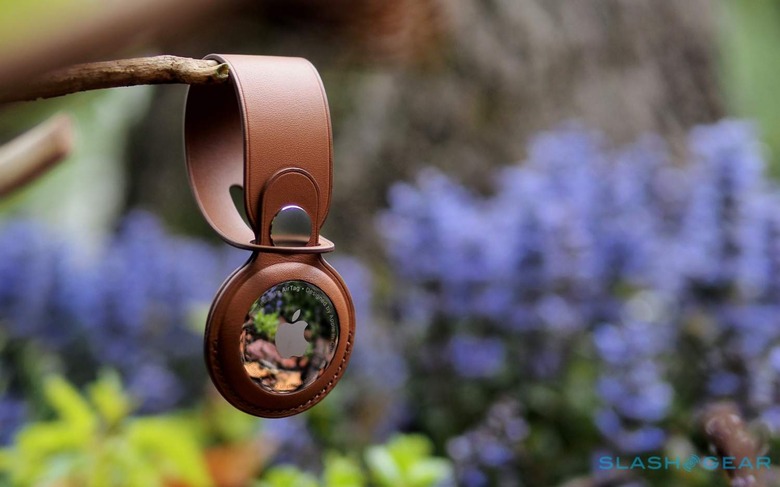
Instead you should budget for some accessories that enable that functionality, whether it be Apple's own AirTag Loop or Key Ring, or something from the lavish Hermés range. Apple sent me the keyring plus a couple of the loops, and they certainly feel sturdy and look as fashionable as they're functional. They also cost $29 apiece, so you might be better off looking at the far cheaper – and growing – array of third-party accessories out there.
At least engraving is free, with Apple offering to put your choice of text or emojis (within its self-imposed limits of good taste, mind) on the white side of the AirTag. You can fit up to four characters on there, enough for some initials or maybe a reminder of what key the tracker is attached to.

While Apple probably would prefer that I switch from carrying a physical wallet full of cards to using Apple Pay and the Apple Wallet app, I'm not quite there yet. The AirTag's form-factor doesn't really suit itself to slotting into the typical billfold wallet, however, which is frustrating since that's one of the primary things I'm concerned about losing.
Time for an AirTag treasure hunt
The U1 chipset doesn't just make pairing easier, it also unlocks the AirTag's biggest crowd-pleaser: directional tracking. Apple calls it Precision Finding, and it means anybody with a U1-equipped iPhone – which currently means models from the iPhone 11 and iPhone 12 families – can get much more accurate directions to their lost item.
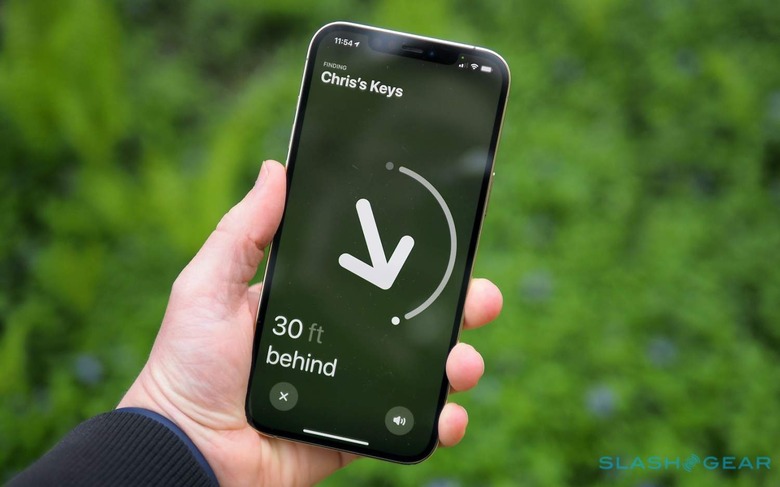
Thanks to Ultra Wideband (UWB), you can see your distance from that item, in which direction it lies, and get visual, audible, and haptic prompts as you come closer. It's an oddly fun experience, though you do need to be closer than about 30 feet or so in an open space, or considerably nearer still if there are walls or floors in-between you and the AirTag.
Sometimes, though, you don't need quite that much help. Using the Find My app – or asking Siri for the AirTag by name – you can make the tracker play a sound. The body of the AirTag itself is used to amplify that, and it's a distinctive sound though it could be louder. At home that's fine, but if you're in a loud public place it's going to be tougher.
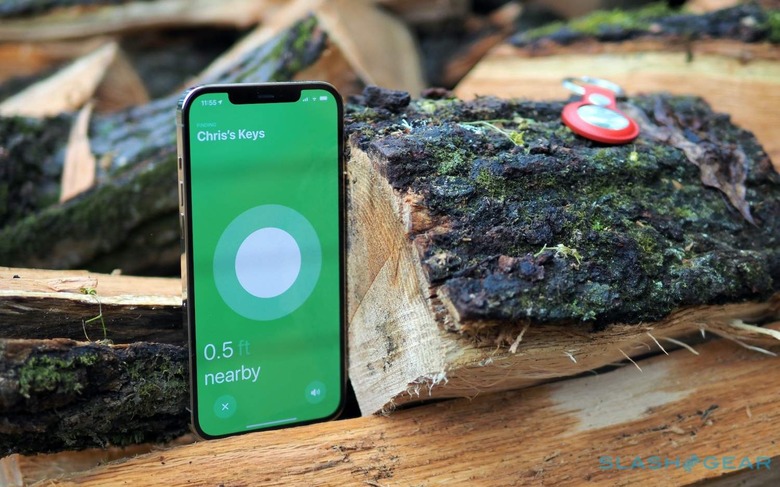
Both UWB and Bluetooth are short-range technologies, of course, and there may well be times your AirTag is beyond their reach from your iPhone. That's where Apple's Find My network comes in, basically tapping every other Apple device (that has opted in) in the wild to keep a Bluetooth eye peeled for the tracker.
If it's within range – and Apple says there are nearly a billion such Apple devices already contributing to its worldwide network – it'll anonymously pass back the lost AirTag's location through iCloud, and from there to your Find My app. That happens without those people in the network knowing it's taking place: they can't see your AirTag nearby themselves, they don't get an alert that their device has acted as a relay, and there's no way to see who in the Find My network actually located the tracker.
How does that work in practice? Unexpectedly well. I'm lucky that, so far at least, I've not had an iPhone, Mac, or other Apple device lost or stolen, which might've required me to try Find My out already, so the extent of the network came as a surprise.
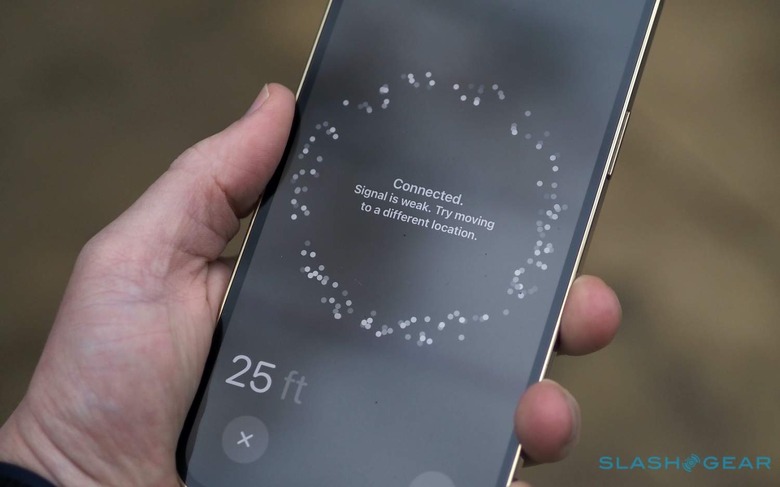
Since it's reliant on internet-connected Apple devices passing within Bluetooth range, Find My obviously works more effectively in urban areas where there's more chance of someone with an iPhone or an iPad wandering nearby. Still, in my testing, it was typically sufficient to get me into the rough area where the AirTag had been hidden. Then you switch to your own Bluetooth and Ultra Wideband connections.
There are some limits to how the tracking works, mind. Most conspicuous is the absence of height data: since the AirTag lacks an altimeter, it can't distinguish if it's on a floor above or below you. Assuming the signal is strong enough to make it between the levels – and that's not always a given – you'll see a distance in feet but the directional arrows won't take into account the disparity in height.
What you end up doing is a mixture of old-school "hunt the beep" and then relying on Bluetooth and UWB for the final search. If AirTag had a built-in cellular radio and GPS, like T-Mobile's SyncUP Tracker, it would be able to more precisely log its own location. The downside, of course, is both price and power, since T-Mobile's version needs a data subscription and weekly charging.
AirTag privacy and safety
Setting an AirTag into Lost Mode means the Find My network keeps a virtual eye out for it; you'll get notified if the tracker's location is pinged. If someone else finds it, and taps it against their iPhone or NFC-equipped Android phone, they'll be taken to a webpage explaining that the AirTag is lost.

That will show the AirTag's serial number, and you can optionally leave your contact number in the hope that they'll call and help reunite you with whatever you misplaced. It's worth noting that there's no way of telling whether someone has actually viewed that page: you don't get a notification when the NFC functionality is used.
You're reliant on their good nature, then, since they could simply follow the accompanying instructions to silence the AirTag's beeping – which is basically "take out the battery" – and keep what it was attached to.
When, exactly, an AirTag beeps is a complicated thing. There's obviously the potential for enabling stalker-like behaviors with any tracker, and so Apple has baked in some precautionary elements to try to avoid someone unknowingly being monitored. If your Apple device spots that an AirTag not registered to you is seemingly following you around, it'll alert you to that fact. The AirTag itself will also start beeping, in case you're not an Apple user.

They're sensible steps, but I'm not sure the defaults are dialed in quite right. For a start, there's a significant gap between someone else's AirTag being identified as following you and the alert showing up on your iPhone or iPad. It can be hours, in fact, during which time someone else could be surreptitiously monitoring your location.
Only those running iOS 14.5 (or iPadOS 14.5) will get those warning notifications, too. Yes, a lot of iPhone owners are quick to update, but a fair number don't, at least not straight away. That leaves them in the same situation as Android users who, since they don't get a warning notification about a rogue AirTag at all, are left waiting for it to start beeping instead. That doesn't happen for about three days.
Apple's settings there are a balance of convenience versus caution, which I get. However I do think they could be dialed in to be a little more stringent, or that iPhone users themselves could choose their own limits as to when they get notified. On the flip-side, it'd be good if a single AirTag could be associated with two different people, so that everyone can track down a shared item.
Apple AirTag Verdict
Losing something is a shortcut to anxiety: nobody likes the feeling of having misplaced their keys, or that stomach-dropping realization that their bag isn't where they thought they left it. In those high-emotion moments, AirTag's convenience and simplicity – especially if you have a Precision Finding-capable phone – is going to be exceptionally welcome. Nobody wants to be troubleshooting at a time like that.
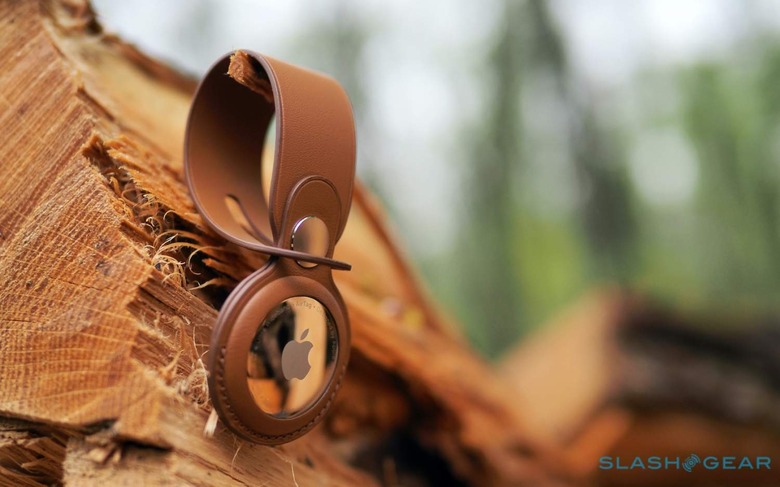
All the same, there's a sense that the Cupertino view of the world is one seen through rosy, Apple-tinted glasses. One where those who stumble across lost but AirTagged items are honest, and where mystery AirTag settings can be dialed by the company to "low annoyance" without potentially enabling a greater stalking risk. That upbeat positivity is fine, at worst a little frustrating, when it's about doing away with older ports on a laptop, but the potential for misuse with AirTags seems much greater.
The good news is that those concerns could be tweaked with software, and I hope Apple takes that onboard with future AirTag-related updates. The trackers themselves aren't a guarantee that you'll find your missing item, but the strength of the Find My network and the convenience of Precision Finding mean it's probably a more likely outcome. That, the relatively low cost, and the absence of a separate subscription fee makes AirTag a no-brainer accessory for iPhone owners.
